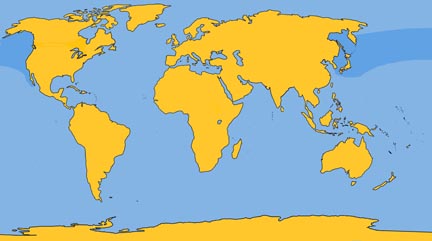
BAIRD’S BEAKED WHALE
Family: Ziphiidae
Genus: Berardius
Species: B. bairdii Stejneger, 1883
Baird’s beaked whales are very gregarious animals, often found in large groups of 30 or more. They and Arnoux’s beaked whale may well represent different populations of the same species; only through the comparison of specimens can this be confirmed or disproven. Baird’s beaked whales are deep divers, frequenting areas of the North Pacific around escarpments and seamounts. They are shy in areas where they have been hunted, but elsewhere may be inquisitive about ships and may be approached closely.
Physical Description: The body is cigar-shaped with a thin rostrum and protruding lower jaw. The rostrum meets a high, rising, well-developed bulbous forehead. The flippers, flukes, and forehead may be somewhat larger than those of its southern counterpart.
Color: Dark Blue dorsally, light gray ventrally, mottled on the flanks.
Fins and Flukes: The small triangular or falcate dorsal fin is located well to the rear of the mid-back region. The flippers are small, paddle-shaped, and rounded at the tips, located higher on the sides than in most cetaceans. The flukes are large, somewhat rounded at the tips, and seldom possess a median notch.
Length and Weight: The largest recorded male was 39 ft (11.9 m) long; the largest recorded female 42 ft (12.8 m). They are estimated to exceed 12 tons (11,000 kg).
Teeth: Two pairs of erupted teeth are in the lower jaw, a triangular pair, about fist size, protrudes visibly fro the tip of the lower jaw. The thumb-sized second pair is located farther back, concealed in the mouth, and separated from the first pair by a considerable space.
Feeding: They are known to feed on squid and small fish.
Breathing and Diving: Both forms of Berardius can dive to depths of 3,300 ft (1,000 m). The dive can last from 20 minutes to an hour.
Mating and Breeding: Calves 15 ft (4.5 m) in length are thought to be born between late November and early May after a gestation period of between 12 and 17 months. Males may attain sexual maturity at about 32 to 36 ft (10 to 11 m); no data are available for females. Calving probably takes place at 3-year intervals. Birthing is thought to occur near the Japanese archipelago, among other possible places.
Herding: Normally these whales congregate in groups of about 6, but herds of up to 40 or more, led by a large male, have been reported.
Distribution: They are found in the North Pacific from Japan and southern California northward to the Bering Sea.
Migration: These animals apparently have a northward movement in their range during the summer months and a southward movement in winter.
Natural History Notes: There is much scarring visible on the body, doubtless from intraspecies fighting. The lifespan is estimated at more than 70 years. This species became known to western scientists from a skull obtained from Bering Island in 1881 by Leonhard Hess Stejneger, a Norwegian-born American ornithologist, herpetologist, and zoologist. Two years later a portion of a skull of the same species was found on Bering Island, but its description was not published until a few months after that of Stejneger’s.
ARNOUX’S BEAKED WHALE
Family: Ziphiidae
Genus: Berardius
Species: B. arnuxii Duvernoy, 1851
Much less well known than its northern counterpart, Arnoux’s beaked whale occurs near deep escarpments and seamounts of the Southern Hemisphere, particularly around New Zealand and Australia. It is known mostly from specimens and photographs of beached or stranded animals, and its habits and behavior are presumed to be similar to Baird’s beaked whale. The distribution of the two species suggests that their populations have been separated since the ice age.
Physical Description: Basically the same as Baird’s beaked whale.
Color: Basically the same as Baird’s beaked whale.
Fins and Flukes: Basically the same as Baird’s beaked whale.
Length and Weight: These whales reach about 30 ft (9 m) and about 9 tons (8,200 kg).
Teeth: Basically the same as Baird’s beaked whale.
Feeding: Squid and bottom-dwelling fish.
Breathing and Diving: They can dive to at least 3,300 ft (1,000 m); the dive may last from 20 minutes to an hour.
Mating and Breeding: Breeding occurs in the South Atlantic and the New Zealand archipelagos from December through March. Gestation is 10 months.
Herding: Basically the same as Baird’s beaked whale. A breeding herd may be dominated by a single bull.
Distribution: They are confined to the southern oceans; known from South Australia, New Zealand, Argentina, Falkland Islands, South Georgia, South Shetlands, South Africa, and Antarctic Peninsula.
Migration: They are presumed to migrate seasonally away from the edge of the ice in winter for breeding, although some have been known to become trapped by shifting ice around Antarctica, and may winter or die there.
Natural History: This species became known to science as a result of a specimen that stranded in Akoroa Harbor, Bank Peninsula, New Zealand, and was presented to the Museum of Paris in 1846 by one M. Arnoux, surgeon to the French corvette Rhin, commanded by Captain Bérard.








